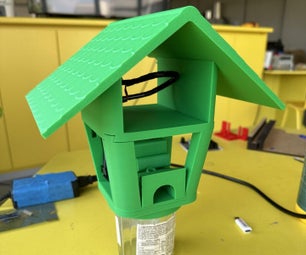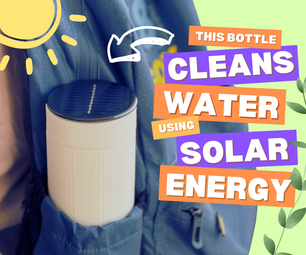Introduction: Night Vision Scope/Camera
In this Instructable you will see how I made a night vision scope/camera. It is capable of recording in very low light. It can be used in many scenarios, even like a dashcam for recording the night footage.
I was inspired by this Instructable:
https://www.instructables.com/DIY-Pocket-sized-Nig...
But I wanted to make it a little more professional, since I am quite handy with designing PCBs. I designed the PCB for all the voltage converters and the battery charging circuit and also the battery protection circuit. I also designed my version of the enclosure. This enclosure allows the camera to be strapped to your head so you don't need to hold it the entire time.
Here is the video showing off the build process and the final demonstration, and in this instructable I will further describe the design process.
The camera consists of mainly 4 components:
- Runcam Night Eagle 2 Pro FPV camera
- Near Eye Monocular Display
- my custom electronics for powering and connecting everything together (can be also done without it)
- optional DVR recorder for recording what you see (otherwise it works just as a scope)
Step 1: Skills, Tools and Parts
This project is quite difficult for a beginner. But you will definitely not need as much equipment as I have on the photo above :)
The beginners should first look at the Instructable that inspired my project (link on the first page) but at the same time, you should also check out my Instructable so you will see what you still have to learn in order to become a "pro" :) But I will also describe the basic principles in my Instructable.
Skills you will need for making this:
- soldering small SMD components (and having the tools for the job)
- 3D printing
- skills for buying stuff from the internet :)
Stuff you will need (not affiliated):
- monocular display:
- Runcam Night Eagle 2 Pro drone FPV camera:
- Optional DVR:
https://s.click.aliexpress.com/e/_9wEXRO
The DVR is not necessary, unless you need to record what you are seeing. I used this one, works great, records great, but it has a little problem - it reduces the fps for the preview from the camera. The image is seen as laggy. But it records a smooth video. So I recommend not using the DVR unless you need to record. Maybe some other DVR will work better, but they are a little bit bigger.
- the parts for the PCB will be listed further in the Instructable
Step 2: The Basic Schematics
If you decide to go the simple way or want to understand my wiring more easily, here is the basic schematic which shows how camera and display are connected together. The first schematic is without DVR and the other one is with DVR.
If you choose to use the same DVR as I used, note that the preview you will see on the display, will seem a bit Laggy. Looks like this DVR is quite slow for previewing. But the recordings come out nicely.
The basic wiring is very simple, if you want to go the simple way, you can do without the PCB.
You need to connect the wires as shown and you need to use a DC-DC converter, to boost the battery voltage to a stable 5V used to power the camera, display and DVR. You want something with a current capability of 1A or more.The circuit draws a bit more than 500mA. Something like that could work and you will also get a charging circuit for the battery. All in one.
https://www.aliexpress.com/item/32793055741.html?s...
(not affiliated)
Step 3: The Detailed Schematics
My schematic(third picture) differs from the basic one in the following parts:
- I added on-board battery protection
- added on-board battery charger
- I added on-board battery voltage to 5V DC converter
I will shortly explain those sub-parts in the following steps.
And of course I added some connectors(the blue items on schematic. Connectors come in handy when assembling and disassembling the assembly. But everything could just be soldered on the board directly and you will solve yourself some hassle if you don't have the tools available. (I also don't own the crimping tools. I borrowed them from work since they are quite expensive).
Step 4: The Battery Protector
This circuit uses a ridiculously miniature BQ29700 IC, which with the help of some components protects the battery from:
- overvoltage
- undervoltage
- overcurrent
So it keeps the battery safe and healthy.
If you use protected 18650 batteries you don't need this circuit as it performs the same function as built-in protection. I had some unprotected cells laying around and I decided to put protection on the board directly.
Step 5: USB Charging Circuit
This circuit charges the battery when you connect the micro USB connector.
It limits the charging circuit to 800mA which enables charging at moderate speed when connected to wall charger.
When the battery is charging, the red LED is on, indicating the charge. When the charge is complete, the LED turns off.
Step 6: The 5V Boost Converter
This circuit generates a stable 5V from the 2.5V-4.2V battery voltage.
It is a simple Boost Converter. (the output voltage is higher than the input voltage)
The switch is connected to the enable circuit which turns the converter on or off. This way, you turn the whole system on or off with a very small low current switch.
The display, camera and DVR combined consume approximately 500mA of current, this small switch I wanted to use is capable of switching only 100mA. By using the switch to operate only the enable signal, I was able to use this tiny switch and save some space.
Step 7: The PCB
I designed a small PCB, holding all these components.
For space saving I put the battery holder on the bottom side.
You can get gerbers here:
https://drive.google.com/file/d/13GhPQQ2v9n4S9GOvP...
With these files, you can get the PCB made, from the providers like JLCPCB
The cost of this board is only 2$ for 5pcs (plus shipping) which is a bargain! Sign up to get $18 new user coupons: https://jlcpcb.com/IAT
You can use coupon code "JLCPCBcom" at checkout for a small discount.
In the attached .pdf, you can see the assembly instructions for soldering the components to PCB, including the bill of materials.
Attachments
Step 8: 3D Printed Enclosure
I designed the enclosure in such way, so it can be held on the head by a strap or headband.
It is indeed the most complicated part I have ever designed :) I am quite proud of it.
It is also very difficult for printing. No matter how you position it on the plate, you will always have some difficult to remove supports or the print will not look as nice. If you have dual extruder printer with water soluble supports you will win :) As you have seen in the video, it took me some time to remove all the supports, but it came out nicely at the end.
And the enclosure somewhat works as it should.
Here are the 3D files:
Step 9: Crimping Wires
You can avoid crimping if you don't have the tools. Soldering is just as cool :) I would also solder the thing together, but I got an opportunity to borrow the crimping tools from work.
I used JST PH type connectors.
I prepared the wires for camera, display, the IR LEDs in the front, the switch which goes on top of the enclosure(for turning on the IR LEDs).
For the camera and display, I simply cut the existing wires at appropriate lengths and revealed the internal wires. You can decode what colour is which on the basic schematics in step 2. The schematic contains the correct colour coding. On the PCB there is a marking print, indicating which wire goes where.
Step 10: Putting It All Together
The PCB slides in the slots in the enclosure. Rest of it is pretty much self explanatory. See the video for some assembly process.
If you have any problems, tell me in the comments.
Step 11: Night Shots
These shots were taken on a remote road, away from all artificial lightning.
The night sky was mostly clear, with almost full moon. You can also see some stars.
The second photo is taken while driving a car with regular halogen lights. You can see that the camera could also be used as a night dashcam as it provides excellent visibility.
The camera also works at bright daylight. It does not get blinded. But it records only black and white.
You can check out more shots in the YouTube video at the beginning of Instructable as the still images don't show the full potential the video looks much more detailed.
Step 12: Enjoy!
I hope you enjoyed my Instructable!
Please vote for it in the Instructable 1000th contest!
Thank you!
If you want to stay in touch on what I am working on:
You can subscribe to my YouTube channel:
http://www.youtube.com/c/JTMakesIt
You can also follow me on Facebook and Instagram
https://www.facebook.com/JTMakesIt
https://www.instagram.com/jt_makes_it
for spoilers on what I am currently working on, behind the scenes and other extras! PS:., if you REALLY, REALLY liked it, you can also buy me a coffee here, so I will have more energy for future projects :)

Runner Up in the
Remix Contest












